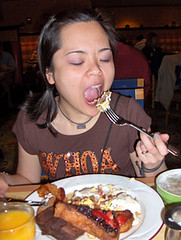Fun Easy Number Theory Proof
I like to show this one to younger students who are disenchanted by algebra.
So, write down any 3 digit number (I started off with "so" because it seems like every math prof I ever had would start their sentences that way...)
Write those 3 digits down twice in the same order so that you have a 6 digit number.
For example:
123 ---> 123123
or
505 ---> 505505
This resulting number will ALWAYS be divisible by 7, 11 and 13 and will always result in the original 3 digit number.
Let's take 123123 to illustrate:
123123 divided by 7 = 17589
17589 divided by 11 = 1599
1599 divided by 13 = 123
So how do you prove this?
It's a surprisingly accessible proof.
The statement "divisible by 7, 11 and 13" is the same as saying "divisible by (7 times 11 times 13)"
"7 times 11 times 13" = 7 x 11 x 13 = 1001
So, really, we're saying the resulting 6 digit number will always be evenly divisible by 1001 (if you recall, evenly divisible means there are no remainders).
***
To state this in general terms:
Let a, b and c be integers between 0 and 9. We form a six digit number in the following way.
abcabc = a(10^5) + b(10^4) + c(10^3)+ a(10^2) + b(10^1)+ c(10^0)
This number will always be divisible by 1001 and the resulting answer will be equal to abc
***
Some reminders:
Any number to the power of zero is equal to 1.
Any number can be written as the sum of integers times powers of 10. For example:
123 = 1(10^2)+ 2(10^1)+ 3(10^0)
= 1(10^2)+ 2(10^1)+ 3(1)
= 1(100) + 2(10) + 3(1)
= 100 + 20 + 3
= 123
***
The proof only involves a lot of factoring:
abcabc = a(10^5) + b(10^4) + c(10^3) + a(10^2) + b(10^1) + c(10^0)
= a(10^5) + b(10^4) + c(10^3) + a(10^2) + b(10^1) + c
= a(10^5) + a(10^2) + b(10^4) + b(10^1) + c(10^3) + c
= a(10^2)[(10^3 +1)] +b(10^1)[(10^3 + 1)] +c[(10^3 + 1)]
= [a(10^2) + b(10^1) + c](10^3 +1)
= [a(10^2) + b(10^1) + c](1001)
= abc(1001)
In other words, abcabc = abc(1001) which means that abcabc is divisible by 1001 and dividing the number by 1001 leaves abc. Proof solved!
So, write down any 3 digit number (I started off with "so" because it seems like every math prof I ever had would start their sentences that way...)
Write those 3 digits down twice in the same order so that you have a 6 digit number.
For example:
123 ---> 123123
or
505 ---> 505505
This resulting number will ALWAYS be divisible by 7, 11 and 13 and will always result in the original 3 digit number.
Let's take 123123 to illustrate:
123123 divided by 7 = 17589
17589 divided by 11 = 1599
1599 divided by 13 = 123
So how do you prove this?
It's a surprisingly accessible proof.
The statement "divisible by 7, 11 and 13" is the same as saying "divisible by (7 times 11 times 13)"
"7 times 11 times 13" = 7 x 11 x 13 = 1001
So, really, we're saying the resulting 6 digit number will always be evenly divisible by 1001 (if you recall, evenly divisible means there are no remainders).
***
To state this in general terms:
Let a, b and c be integers between 0 and 9. We form a six digit number in the following way.
abcabc = a(10^5) + b(10^4) + c(10^3)+ a(10^2) + b(10^1)+ c(10^0)
This number will always be divisible by 1001 and the resulting answer will be equal to abc
***
Some reminders:
Any number to the power of zero is equal to 1.
Any number can be written as the sum of integers times powers of 10. For example:
123 = 1(10^2)+ 2(10^1)+ 3(10^0)
= 1(10^2)+ 2(10^1)+ 3(1)
= 1(100) + 2(10) + 3(1)
= 100 + 20 + 3
= 123
***
The proof only involves a lot of factoring:
abcabc = a(10^5) + b(10^4) + c(10^3) + a(10^2) + b(10^1) + c(10^0)
= a(10^5) + b(10^4) + c(10^3) + a(10^2) + b(10^1) + c
= a(10^5) + a(10^2) + b(10^4) + b(10^1) + c(10^3) + c
= a(10^2)[(10^3 +1)] +b(10^1)[(10^3 + 1)] +c[(10^3 + 1)]
= [a(10^2) + b(10^1) + c](10^3 +1)
= [a(10^2) + b(10^1) + c](1001)
= abc(1001)
In other words, abcabc = abc(1001) which means that abcabc is divisible by 1001 and dividing the number by 1001 leaves abc. Proof solved!
Labels: math



2 Comments:
Cool! Did you come up with this yourself? I've never seen it before - but then again I've never studied number theory surprizingly enough.
I came up with the proof on my own, but not the problem. I think I first saw it on a homework set for number theory class, but it just struck me how easy the proof is...it's just factoring. If they included HW problems like this for kiddos in algebra, it might pique their interest more.
Post a Comment
<< Home